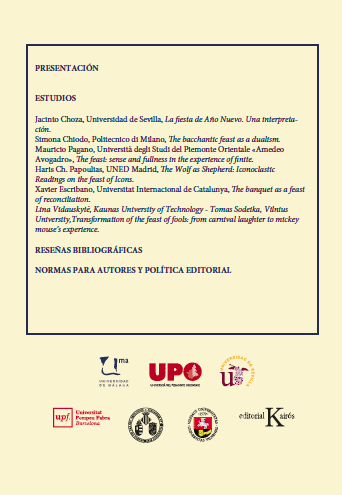The Wolf as a Shepherd: Iconoclastic readings on the Feast of Icons and its legacy
DOI:
https://doi.org/10.24310/Raphisa.2018.v0i4.7391Palabras clave:
Feast of Icons, Iconoclasm, Images, Hegel, Byzantine Aesthetics,Resumen
A very special kind of feast belongs to the Christian Orthodox tradition: there is a specific liturgical celebration of the Images in the so-called Sunday of Orthodoxy. While in many cultures images are employed in order to celebrate an historic event, this is the only feast in which, on the contrary, images are celebrated for themselves. Nonetheless, the role of images in Orthodoxy is not univocally and positively accepted. In fact, the title’s expression .the wolf as a shepherd. belongs to a Desert Father and refers to the role of images in our mental life. This is not reported by a heretical iconoclastic document, but by the well-known Philokalia, a kind of handbook of Orthodox Aesthetics. This paper aims to present these two aspects in their paradoxical partnership. First, I will present some historical, symbolic and liturgical aspects of this feast. Thus, we should be able to understand better why many contemporary authors claimed that the origins of our visual culture can be traced in this Feast. However, if we comprehend the philosophical value of Byzantine icons, we realise that they have little to do with our contemporary images, no matter whether we mean artistic, religious or media images. We often talk about the .power of images., but just to blame them -as if they were autonomous entities- or to praise them, in a generalized aestheticization of contemporary life. Iconophobia and iconodoulia, I claim, are emerging as ontologically impoverished versions of the former Byzantine theoretical models. What falls into oblivion is the paradoxical status of the image as .appearance of the essence of Being. that demands as a condition of its own existence its self-sublation. These dialectics, conceptually inspired by the Hegelian logic, are fully present in Byzantine Aesthetics, where the feast is considered as a precarious image, held in memory of a future image-loss event known as eschaton.
Descargas
Métricas
Descargas
Publicado
Cómo citar
Número
Sección
Licencia
Los textos publicados en Raphisa son de dominio público. Tras la publicación en RAPHISA, los autores mantienen todos los derechos de autor, sin restricciones, y el copyright de sus textos.






